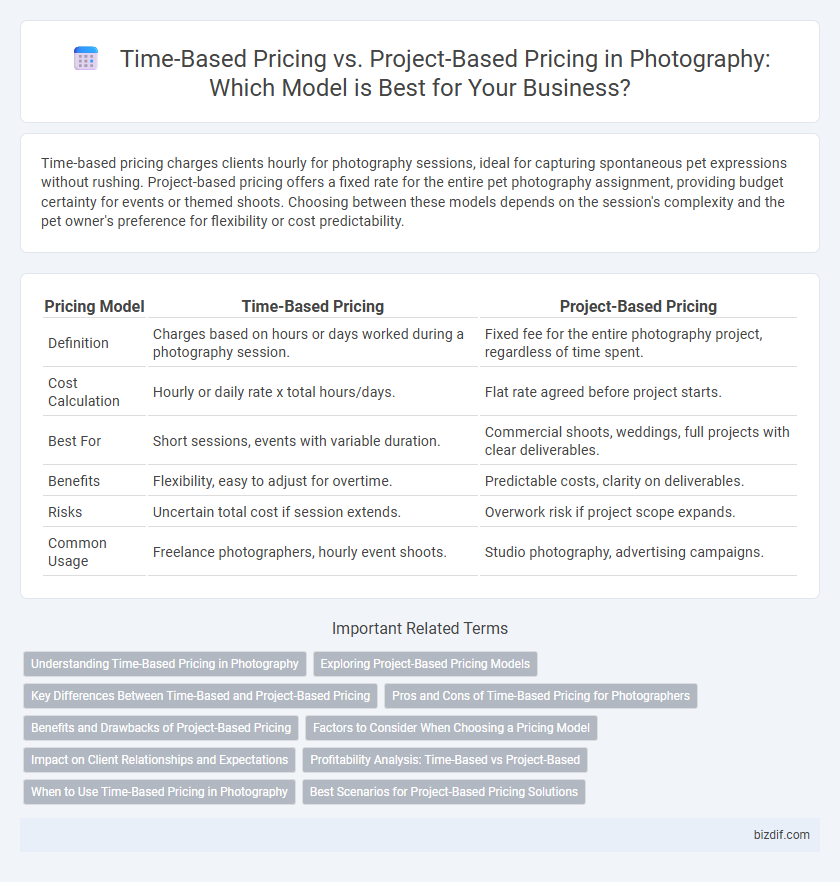Time-based pricing charges clients hourly for photography sessions, ideal for capturing spontaneous pet expressions without rushing. Project-based pricing offers a fixed rate for the entire pet photography assignment, providing budget certainty for events or themed shoots. Choosing between these models depends on the session's complexity and the pet owner's preference for flexibility or cost predictability.
Table of Comparison
| Pricing Model | Time-Based Pricing | Project-Based Pricing |
|---|---|---|
| Definition | Charges based on hours or days worked during a photography session. | Fixed fee for the entire photography project, regardless of time spent. |
| Cost Calculation | Hourly or daily rate x total hours/days. | Flat rate agreed before project starts. |
| Best For | Short sessions, events with variable duration. | Commercial shoots, weddings, full projects with clear deliverables. |
| Benefits | Flexibility, easy to adjust for overtime. | Predictable costs, clarity on deliverables. |
| Risks | Uncertain total cost if session extends. | Overwork risk if project scope expands. |
| Common Usage | Freelance photographers, hourly event shoots. | Studio photography, advertising campaigns. |
Understanding Time-Based Pricing in Photography
Time-based pricing in photography involves charging clients according to the hours or days spent on a shoot, editing, and post-production work. This approach allows photographers to account for variations in project complexity and unforeseen time demands, ensuring fair compensation. Understanding time-based pricing helps photographers effectively manage their workload and align their earnings with the effort and time invested in each project.
Exploring Project-Based Pricing Models
Project-based pricing in photography offers a fixed fee tailored to the unique scope and deliverables of each assignment, providing transparency and budget predictability for clients. This model encourages photographers to account for variables such as location, complexity, post-processing time, and usage rights, aligning fees with the complete value of the project. Adopting project-based pricing enhances client satisfaction and profitability by clearly defining expectations and mitigating the risks of underestimated time investment.
Key Differences Between Time-Based and Project-Based Pricing
Time-based pricing charges clients according to the hours spent on a photography project, offering flexibility for unpredictable shoot durations and post-processing but may lead to uncertain final costs. Project-based pricing provides a fixed rate for the entire photography assignment, giving clients budget clarity and encouraging photographers to work efficiently while accounting for all deliverables such as editing, retouching, and licensing. Photographers must weigh factors like shoot complexity, client expectations, and potential revisions to choose the optimal pricing model between hourly billing and flat-rate project fees.
Pros and Cons of Time-Based Pricing for Photographers
Time-based pricing allows photographers to charge clients based on the actual hours spent, offering flexibility and fair compensation for unpredictable project scopes. This method ensures income reflects effort, but can result in client concerns over budget overruns and challenges in accurately estimating total hours upfront. Photographers may also face income instability if booked projects require less time than anticipated or if administrative tasks consume unpaid hours.
Benefits and Drawbacks of Project-Based Pricing
Project-based pricing in photography offers clear cost expectations and simplifies budgeting for clients by providing a fixed fee regardless of hours spent. However, it can lead to undercharging if a project requires more time or resources than anticipated, potentially reducing the photographer's profitability. This pricing model encourages efficient workflow but limits flexibility to adjust rates based on project complexity or changes.
Factors to Consider When Choosing a Pricing Model
Choosing between time-based pricing and project-based pricing in photography depends on factors such as the complexity and scope of the shoot, client requirements, and anticipated post-production effort. Time-based pricing benefits projects with variable hours or unpredictable challenges, ensuring photographers are compensated for every minute worked. Project-based pricing suits clearly defined assignments with set deliverables, providing clients with upfront cost certainty and fostering trust.
Impact on Client Relationships and Expectations
Time-based pricing in photography offers clients transparency and flexibility, enabling adjustments based on the project's evolving scope, which fosters trust and clear expectations. Project-based pricing provides clients with predictable costs, simplifying budgeting and reducing anxiety about overruns, strengthening confidence in service delivery. Balancing these models carefully can enhance client satisfaction, ensuring alignment between creative outcomes and financial expectations.
Profitability Analysis: Time-Based vs Project-Based
Time-based pricing calculates fees according to hours spent, which can lead to undercharging on complex projects and reduced profitability if time estimates are inaccurate. Project-based pricing sets a fixed fee regardless of hours worked, allowing photographers to maximize profits by efficiently managing their workflow and delivering value beyond time invested. Analyzing profitability reveals project-based pricing often yields higher and more predictable income, especially for experienced photographers with streamlined processes.
When to Use Time-Based Pricing in Photography
Time-based pricing in photography is ideal for hourly or daily shoots such as events, portraits, or commercial sessions where the scope and deliverables may vary. Photographers benefit from this approach when clients request flexible shooting times or multiple location setups, allowing accurate compensation for additional hours or changes. This method ensures transparent billing for time-intensive projects and accommodates unforeseen delays or extended client interactions.
Best Scenarios for Project-Based Pricing Solutions
Project-based pricing is ideal for photography assignments with clearly defined deliverables and timelines, such as weddings, corporate events, or product shoots. This pricing method ensures photographers can account for all project-specific costs, including pre-production, shooting, and post-processing, providing clients with a fixed rate upfront. It works best when clients require a comprehensive package with a final product, avoiding variable hourly fees and simplifying budget planning.
Time-Based Pricing vs Project-Based Pricing Infographic

 bizdif.com
bizdif.com